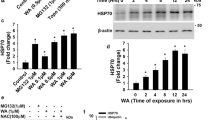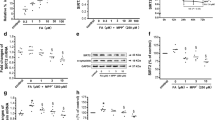Abstract
Parkinson’s disease (PD) is the second most prevalent neurodegenerative disease. The pathology of PD is caused by progressive degeneration of dopaminergic neurons and is characterized by the presence of intracellular inclusions known as Lewy bodies, composed mainly of α-synuclein. Heat shock proteins (HSPs) are crucial in protein quality control in cells. HSP70 in particular prevents the aggregation of protein aggregation, such as α-synuclein, providing a degree of protection against PD. The compound FLZ has been shown to protect several PD models in previous studies and was reported as an HSP inducer to protect against MPP+-induced neurotoxicity, but the mechanism remains unclear. In this study, we investigated the effects of FLZ-mediated HSP70 induction in α-synuclein transgenic mice and cells. FLZ treatment alleviated motor dysfunction and improved dopaminergic neuronal function in α-synuclein transgenic mice. HSP70 protein expression and transcriptional activity were increased by FLZ treatment, eliciting a reduction of α-synuclein aggregation and associated toxicity. The inhibition of HSP70 by quercetin or HSP70 siRNA markedly attenuated the neuroprotective effects of FLZ, confirming that FLZ exerted a neuroprotective effect through HSP70. We revealed that FLZ directly bound to and increased the expression of Hip, a cochaperone of HSP70, which in turn enhanced HSP70 activity. In conclusion, we defined a critical role for HSP70 and its cochaperones activated by FLZ in preventing neurodegeneration and proposed that targeting the HSP70 system may represent a potential therapy for α-synuclein-related diseases, such as PD.







Similar content being viewed by others
References
de Lau LM, Breteler MM (2006) Epidemiology of Parkinson’s disease. Lancet Neurol 5:525–535
Cheng FR, Vivacqua G, Yu S (2011) The role of α-synuclein in neurotransmission and synaptic plasticity. J Chem Neuroanat 42:242–248
Tönges L, Szegö EM, Hause P, Saal KA, Tatenhorst L, Koch JC, D Hedouville Z, Dambeck V, Kügler S et al (2014) Alpha-synuclein mutations impair axonal regeneration in models of Parkinson’s disease. Front Aging Neurosci 6:239
Ikeda M, Kawarabayashi T, Harigaya Y, Sasaki A, Yamada S, Matsubara E, Murakami T, Tanaka Y, Kurata T et al (2009) Motor impairment and aberrant production of neurochemicals in human alpha-synuclein A30P + A53T transgenic mice with alpha-synuclein pathology. Brain Res 1250:232–241
Taymans JM, Baekelandt V (2014) Phosphatases of α-synuclein, LRRK2, and tau: important players in the phosphorylation-dependent pathology of Parkinsonism. Front Genet 5:382
Mullin S, Schapira AH (2015) Pathogenic mechanisms of neurodegeneration in Parkinson disease. Neurol Clin 33:1–17
Ebrahimi-Fakhari D, Cantuti-Castelvetri I, Fan Z, Rockenstein E, Masliah E, Hyman BT, McLean PJ, Unni VK (2011) Distinct roles in vivo for the ubiquitin-proteasome system and the autophagy- lysosomal pathway in the degradation of {alpha}-synuclein. J Neurosci 31:14508–14520
Aridon P, Geraci F, Turturici G, D’Amelio M, Savettieri G, Sconzo G (2011) Protective role of heat shock proteins in Parkinson’s disease. Neurodegener Dis 8:155–168
Bozaykut P, Ozer NK, Karademir B (2014) Regulation of protein turnover by heat shock proteins. Free Radic Biol Med 77:195–209
Auluck PK, Chan HY, Trojanowski JQ, Lee VM, Bonini NM (2002) Chaperone suppression of alphasynuclein toxicity in a Drosophila model for Parkinson’s disease. Science 295:865–868
Pemberton S, Madiona K, Pieri L, Kabani M, Bousset L, Melki R (2011) Hsc70 protein interaction with soluble and fibrillar alpha-synuclein. J Biol Chem 286:34690–34699
Moloney TC, Hyland R, O’Toole D, Paucard A, Kirik D, O’Doherty A, Gorman AM, Dowd E (2014) Heat shock protein 70 reduces α-synuclein-induced predegenerative neuronal dystrophy in the α-synuclein viral gene transfer rat model of Parkinson’s disease. CNS Neurosci Ther 20:50–58
Danzer KM, Ruf WP, Putcha P, Joyner D, Hashimoto T, Glabe C, Hyman BT, McLean PJ (2011) Heat shock protein 70 modulates toxic extracellular alpha-synuclein oligomers and rescues transsynaptic toxicity. FASEB J 25:326–336
Dong Z, Wolfer DP, Lipp HP, Bueler H (2005) Hsp70 gene transfer by adeno-associated virus inhibits MPTP-induced nigrostriatal degeneration in the mouse model of Parkinson disease. Mol Ther 11:80–88
Wu YR, Wang CK, Chen CM, Hsu Y, Lin SJ, Lin YY, Fung HC, Chang KH, Lee-Chen GJ (2004) Analysis of heat-shock protein 70 gene polymorphisms and the risk of Parkinson’s disease. Hum Genet 114:236–241
Olanow CW, Jankovic J (2005) Neuroprotective therapy in Parkinson’s disease and motor complications: a search for a pathogenesis-targeted, disease-modifying strategy. Mov Disord 20(Suppl 11):S3–S10
Bao XQ, Kong XC, Qian C, Zhang D (2012) FLZ protects dopaminergic neuron through activating protein kinase B/mammalian target of rapamycin pathway and inhibiting RTP801 expression in Parkinson’s disease models. Neuroscience 202:396–404
Bao XQ, Kong XC, Kong LB, Wu LY, Sun H, Zhang D (2014) Squamosamide derivative FLZ protected dopaminergic neuron by activating Akt signaling pathway in 6-OHDA-induced in vivo and in vitro Parkinson’s disease models. Brain Res 1547:49–57
Bao XQ, Wu LY, Wang XL, Sun H, Zhang D (2015) Squamosamide derivative FLZ protected tyrosine hydroxylase function in a chronic MPTP/probenecid mouse model of Parkinson’s disease. Naunyn Schmiedebergs Arch Pharmacol 388:549–556
Kong XC, Zhang D, Qian C, Liu GT, Bao XQ (2011) FLZ, a novel HSP27 and HSP70 inducer, protects SH-SY5Y cells from apoptosis caused by MPP(+). Brain Res 1383:99–107
Molochnikov L, Rabey JM, Dobronevsky E, Bonucelli U, Ceravolo R, Frosini D, Grünblatt E, Riederer P, Jacob C et al (2012) A molecular signature in blood identifies early Parkinson’s disease. Mol Neurodegener 7:26
Fernández-Montesinos R, de Jong J, van Ham TJ, Nollen EA, Pozo D, Christodoulou J, Dobson CM (2009) Chaperone proteostasis in Parkinson’s disease: stabilization of the Hsp70/α-synuclein complex by Hip. EMBO J 28:3758–3770
Donmez G, Arun A, Chung CY, McLean PJ, Lindquist S, Guarente L (2012) SIRT1 protects against α-synuclein aggregation by activating molecular chaperones. J Neurosci 32:124–132
Nakamura K, Nemani VM, Azarbal F, Skibinski G, Levy JM, Egami K, Munishkina L, Zhang J, Gardner B et al (2011) Direct membrane association drives mitochondrial fission by the Parkinson disease-associated protein alpha-synuclein. J Biol Chem 286:20710–20726
Bae EJ, Yang NY, Lee C, Lee HJ, Kim S, Sardi SP, Lee SJ (2015) Loss of glucocerebrosidase 1 activity causes lysosomal dysfunction and α-synuclein aggregation. Exp Mol Med 47:e153
Tsigelny IF, Sharikov Y, Kouznetsova VL, Greenberg JP, Wrasidlo W, Overk C, Gonzalez T, Trejo M, Spencer B et al (2015) Molecular determinants of α-synuclein mutants’ oligomerization and membrane interactions. ACS Chem Neurosci 6:403–416
Ostrerova N, Petrucelli L, Farrer M, Mehta N, Choi P, Hardy J, Wolozin B (1999) α-Synuclein shares physical and functional homology with 14-3-3 proteins. J Neurosci 19:5782–5791
Giasson BI, Duda JE, Quinn SM, Zhang B, Trojanowski JQ, Lee VM (2002) Neuronal α-synucleinopathy with severe movement disorder in mice expressing A53T human α-synuclein. Neuron 34:521–533
Klucken J, Ingelsson M, Shin Y, Irizarry MC, Hedley-Whyte ET, Frosch M, Growdon J, McLean P, Hyman BT (2006) Clinical and biochemical correla tes of insoluble alpha-synuclein in dementia with Lewy bodies. Acta Neuropathol 111:101–108
Luk KC, Mills IP, Trojanowski JQ, Lee VM (2008) Interactions between Hsp70 and the hydrophobic core of alpha-synuclein inhibit fibril assembly. Biochemistry 47:12614–12625
Outeiro TF, Putcha P, Tetzlaff JE, Spoelgen R, Koker M, Carvalho F, Hyman BT, McLean PJ (2008) Formation of toxic oligomeric alpha-synuclein species in living cells. PLoS One 3:e1867
Kilpatrick K, Novoa JA, Hancock T, Guerriero CJ, Wipf P, Brodsky JL, Segatori L (2013) Chemical induction of Hsp70 reduces α-synuclein aggregation in neuroglioma cells. ACS Chem Biol 8:1460–1468
Thakur P, Nehru B (2014) Long-term heat shock proteins (HSPs) induction by carbenoxolone improves hallmark features of Parkinson’s disease in a rotenone-based model. Neuropharmacology 79:190–200
Putcha P, Danzer KM, Kranich LR, Scott A, Silinski M, Mabbett S, Hicks CD, Veal JM, Hyman BT et al (2010) Brain-permeable small-molecule inhibitors of Hsp90 prevent alpha-synuclein oligomer formation and rescue alpha-synuclein-induced toxicity. J Pharmacol Exp Ther 332:849–857
Kim N, Kim JY, Yenari MA (2015) Pharmacological induction of the 70-kDa heat shock protein protects against brain injury. Neuroscience 284:912–919
Leng Y, Marinova Z, Reis-Fernandes MA, Nau H, Chuang DM (2010) Potent neuroprotective effects of novel structural derivatives of valproic acid: potential roles of HDAC inhibition and HSP70 induction. Neurosci Lett 476:127–132
Cleren C, Calingasan NY, Chen J, Beal MF (2005) Celastrol protects against MPTP- and 3-nitropropionic acid-induced neurotoxicity. J Neurochem 94:995–1004
Shimshek DR, Mueller M, Wiessner C, Schweizer T, van der Putten PH (2010) The HSP70 molecular chaperone is not beneficial in a mouse model of alpha-synucleinopathy. PLoS One 5:e10014
Howarth JL, Glover CP, Uney JB (2009) HSP70 interacting protein prevents the accumulation of inclusions in polyglutamine disease. J Neurochem 108:945–951
Velten M, Villoutreix BO, Ladjimi MM (2000) Quaternary structure of the HSC70 cochaperone HIP. Biochemistry 39:307–315
Li Z, Hartl FU, Bracher A (2013) Structure and function of Hip, an attenuator of the Hsp70 chaperone cycle. Nat Struct Mol Biol 20:929–935
Scherzer CR, Eklund AC, Morse LJ, Liao Z, Locascio JJ, Fefer D, Schwarzschild MA, Schlossmacher MG, Hauser MA et al (2007) Molecular markers of early Parkinson’s disease based on gene expression in blood. Proc Natl Acad Sci U S A 104:955–960
Acknowledgments
This work was supported by grants from the National Science Foundation of China (No. 81000568), the Chinese National Basic Research Program (973 program, No. 2011CB504105), Beijing NOVA Program (2011109), Beijing City Talents (2012D0009008000005), and supported by the Program for New Century Excellent Talents in University (3332013128).
Conflict of Interest
The authors declare no conflict of interest.
Author information
Authors and Affiliations
Corresponding author
Rights and permissions
About this article
Cite this article
Bao, XQ., Wang, XL. & Zhang, D. FLZ Attenuates α-Synuclein-Induced Neurotoxicity by Activating Heat Shock Protein 70. Mol Neurobiol 54, 349–361 (2017). https://doi.org/10.1007/s12035-015-9572-9
Received:
Accepted:
Published:
Issue Date:
DOI: https://doi.org/10.1007/s12035-015-9572-9




